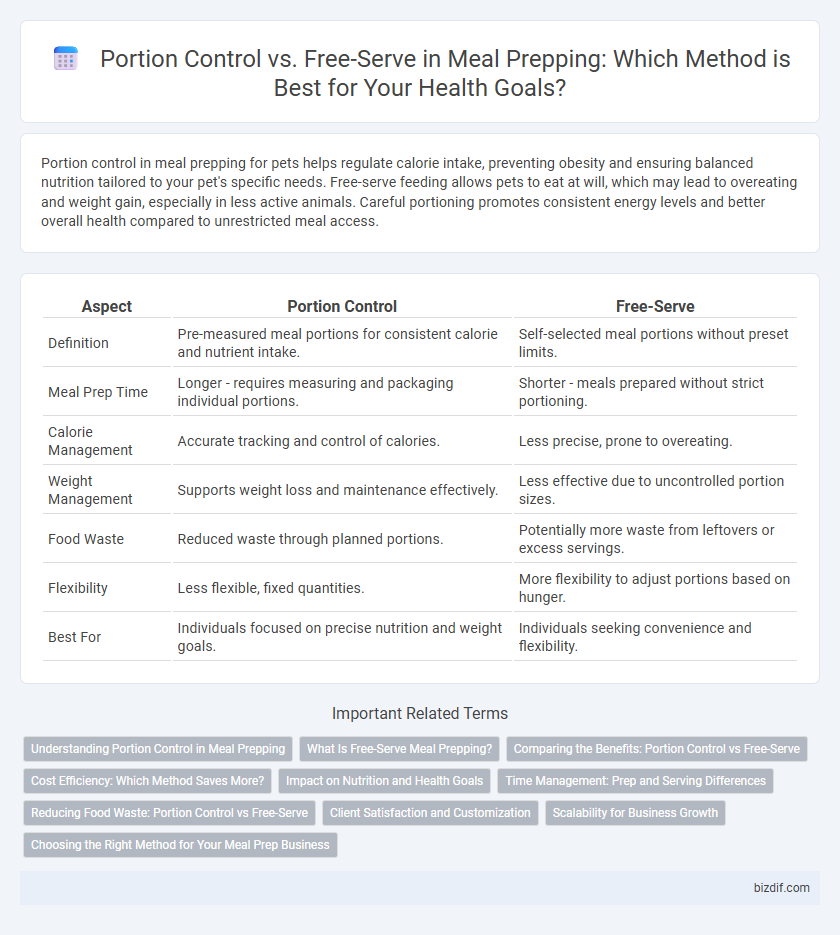Portion control in meal prepping for pets helps regulate calorie intake, preventing obesity and ensuring balanced nutrition tailored to your pet's specific needs. Free-serve feeding allows pets to eat at will, which may lead to overeating and weight gain, especially in less active animals. Careful portioning promotes consistent energy levels and better overall health compared to unrestricted meal access.
Table of Comparison
| Aspect | Portion Control | Free-Serve |
|---|---|---|
| Definition | Pre-measured meal portions for consistent calorie and nutrient intake. | Self-selected meal portions without preset limits. |
| Meal Prep Time | Longer - requires measuring and packaging individual portions. | Shorter - meals prepared without strict portioning. |
| Calorie Management | Accurate tracking and control of calories. | Less precise, prone to overeating. |
| Weight Management | Supports weight loss and maintenance effectively. | Less effective due to uncontrolled portion sizes. |
| Food Waste | Reduced waste through planned portions. | Potentially more waste from leftovers or excess servings. |
| Flexibility | Less flexible, fixed quantities. | More flexibility to adjust portions based on hunger. |
| Best For | Individuals focused on precise nutrition and weight goals. | Individuals seeking convenience and flexibility. |
Understanding Portion Control in Meal Prepping
Portion control in meal prepping involves precisely measuring ingredients to create balanced meals that meet dietary goals and prevent overeating. Tracking macronutrients and calories helps maintain weight management while ensuring nutritional needs are met. Using containers with predefined serving sizes or digital scales enhances accuracy and supports consistent healthy eating habits.
What Is Free-Serve Meal Prepping?
Free-serve meal prepping allows individuals to prepare a variety of meals in advance without strict portioning, giving flexibility to serve according to hunger or preference. This approach contrasts with portion control, where meals are pre-divided into fixed servings to manage calorie intake and nutritional balance. Free-serve meal prepping supports spontaneous eating habits and reduces food waste by adapting serving sizes to daily needs.
Comparing the Benefits: Portion Control vs Free-Serve
Portion control enhances meal prepping by ensuring calorie accuracy and reducing food waste, promoting balanced nutrition and consistent energy levels. Free-serve allows flexibility and spontaneous eating habits, catering to variable hunger cues and fostering a relaxed dining experience. Choosing portion control often supports weight management goals, while free-serve encourages intuitive eating without strict restrictions.
Cost Efficiency: Which Method Saves More?
Portion control in meal prepping significantly reduces food waste by ensuring consistent serving sizes, leading to greater cost efficiency compared to free-serve methods where excess portions often increase ingredient consumption. Pre-measured meals also streamline grocery shopping and budgeting, allowing precise purchase quantities that minimize overspending. Free-serve approaches risk higher overall food expenses due to variable portion sizes and increased likelihood of leftovers being discarded.
Impact on Nutrition and Health Goals
Portion control in meal prepping ensures consistent calorie intake, supporting weight management and balanced nutrition by preventing overeating and nutrient imbalances. Free-serve approaches often lead to unpredictable portion sizes, which can result in excessive calorie consumption and hinder health goals like fat loss or muscle gain. Precise portioning aligns with individualized dietary needs, optimizing macronutrient ratios and sustaining energy levels throughout the day.
Time Management: Prep and Serving Differences
Portion control in meal prepping significantly reduces serving time by pre-measuring ingredients, allowing for quick assembly and minimizing decision fatigue during meals. Free-serve methods require more time during serving as individuals select their amounts, increasing the likelihood of uneven portions and extended meal prep periods. Efficient time management in portion control streamlines both prep and serving stages, contributing to consistent meals and reduced overall workload.
Reducing Food Waste: Portion Control vs Free-Serve
Portion control significantly reduces food waste by limiting servings to predetermined amounts, preventing overeating and uneaten leftovers. Free-serve methods often lead to excessive food on plates, increasing the likelihood of waste. Implementing portion control ensures more efficient ingredient use and supports sustainable meal prepping practices.
Client Satisfaction and Customization
Portion control in meal prepping enhances client satisfaction by providing consistent, calorie-appropriate servings tailored to individual dietary goals, reducing food waste and promoting healthier eating habits. Free-serve options offer greater customization, allowing clients to adjust portion sizes based on hunger levels and preferences, fostering a flexible dining experience. Balancing portion control with customizable choices ensures meals meet nutritional needs while accommodating personal tastes, driving higher client engagement and satisfaction.
Scalability for Business Growth
Portion control streamlines meal prepping by standardizing serving sizes, which enhances inventory management and reduces food waste, directly supporting scalability in business growth. Free-serve models, while offering flexibility to customers, complicate cost forecasting and inventory consistency, potentially hindering efficient expansion. Implementing portion control optimizes operational efficiency, enabling businesses to scale production and maintain quality across multiple locations.
Choosing the Right Method for Your Meal Prep Business
Portion control ensures consistent serving sizes, reduces food waste, and maintains cost efficiency critical for meal prep businesses. Free-serve allows customer customization and can enhance satisfaction but may lead to variable food costs and inventory challenges. Evaluating target market preferences and operational capacity helps determine the ideal balance between portion control and free-serve for optimizing profitability and customer experience.
Portion Control vs Free-Serve Infographic

 bizdif.com
bizdif.com